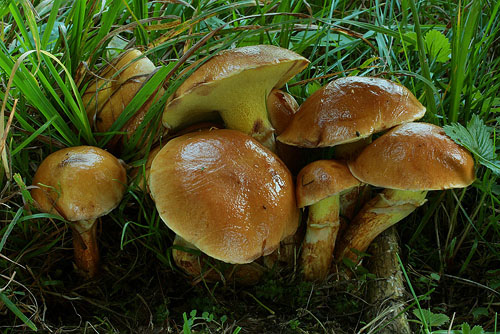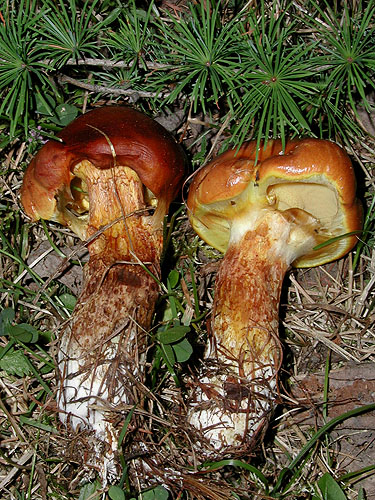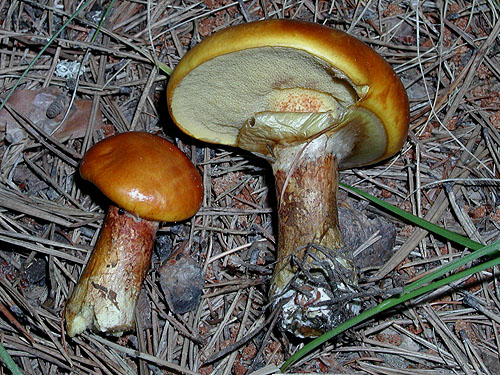Suillus Adans.
A number of species are known in Europe. Fruitbody boletoid without or with partial veil, and then leaving a ring on the stipe. Cap in most species more or less viscid. Stipe solid.
Suillus grevillei (L.) Roussel
Description
Fruitbody with partial veil, leaving more or less visible ring on the stipe. Cap up to 10 cm, at first hemispherical then expanding to convex, pale yellow, yellow, orange-yellow to orange (var. grevillei) or brown to dark brown (var. clintonianus (Peck) Singer), viscid. Stipe, cylindrical or clavate, whitish below the ring and in the stipe base, elsewhere almost concolorous with the cap, with more or less distinct ring Flesh pale yellowish. Tubes yellow. Pores medium sized, yellow. Smell not distinctive. Taste slightly acid. Spores 7–11 × 3–4 μm.
Habitat. Coniferous forests, sometimes artificial plantations, mycorrhizal with larch (Larix).
Distribution. In Europe spread within the natural range of larch and also often seen where larches are introduced. Suillus grevillei var. clintonianus has been found so far only in Northern Europe.
Photographs

Fruitbodies of Suillus grevillei. (photo M. Mikšík)

Fruitbody of Suillus grevillei. (photo B. Assyov)

Fruitbodies of Suillus grevillei. (photo B. Assyov)

Fruitbodies of Suillus grevillei. The torn partial veil is clearly seen on the larger fruitbody. (photo B. Assyov)
See also
Boerio Gianluigi’s photo of Suillus grevillei var. clintonianus
Suillus grevillei var. clintonianus on Fungi Italiani (scroll down when loaded)
Suillus grevillei var. clintonianus on Acta Fungorum (scroll down when loaded)
Important literature
Alessio, C.L. 1985. Boletus Dill. ex L. (sensu lato). – In: Fungi Europaei. Vol. 2. Pp. 1–705. Libreria editrice Biella Giovanna, Saronno.
Breitenbach J. & Kränzlin F. 1991. Pilze der Schweiz. Bd. 3(1). Röhrlinge und Blätterpilze. Verlag Mykologia, Luzern.
Engel, H., Dermek, A., Klofac, W., Ludwig, E. & Brückner, T. 1996. Schmier – und Filzröhrlinge s. l. in Europa. Die Gattungen Boletellus, Boletinus, Phylloporus, Suillus, Xerocomus. Verlag Heinz Engel, Weidhausen b. Coburg.
Estadès, A. & Lannoy, G. 2004. Les bolets européens. – Bulletin Mycologique et Botanique Dauphiné-Savoie 44(3): 3–79.
Galli, R. 1998. I Boleti. Atlante pratico-monographico per la determinazione dei boleti. Edinatura, Milano.
Gerhold, H. 1985. The section Larigni of the genus Suillus and the subgenus Laricogomphus of the genus Gomphidius (Basidiomycetes: Boletales). – Berichte des Naturwissenschaftlich Medizinischen Vereins in Innsbruck 72: 53-64.
Knudsen, H. & Vesterholt, J. [eds.]. 2008. Funga Nordica. Nordsvamp, Kopenhagen.
Lannoy, G. & Estadès, A. 2001. Les Bolets. Flore mycologique d’Europe. Documents Mycologiques Mémoire Hors série no. 6. Pp. 1–163. Association d’Écologie et de Mycologie, Lille.
Muñoz, J.A. 2005. Boletus s. l. – In: Fungi Europaei. Vol. 1. Pp. 1–951. Edizioni Candusso, Alassio.
Šutara, J., Mikšík, M. & Janda, V. 2009. Hřibovité houby. Čeled’ Boletaceae a rody Gyrodon, Gyroporus, Boletinus a Suillus. Academia, Praha.
Watling, R. 1970. Boletaceae, Gomphidiaceae, Paxillaceae. – In: Henderson, D.M., Orton, P.D. & Watling, R. [eds]. British fungus flora. Agarics and Boleti. Vol. 1. Royal Botanic Garden, Edinburgh.
Watling, R. & Hills, A.E. 2005. Boletes and their allies (revised and enlarged edition). – In: Henderson, D.M., Orton, P.D. & Watling, R. [eds]. British Fungus Flora. Agarics and boleti. Vol. 1. Royal Botanic Garden, Edinburgh.